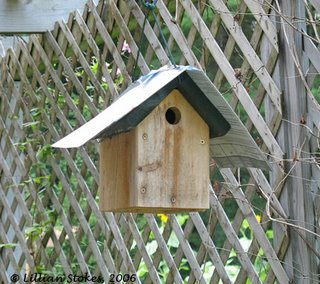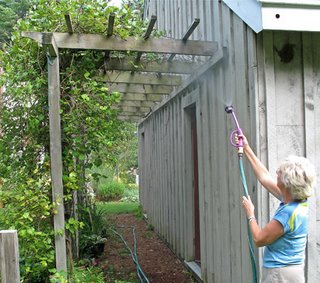Thursday, June 27, 2013
Baby Blues! Eastern Bluebirds
Mrs. Bluebird feeding her fledgling son at our feeder filled with dried mealworms. Awww how cute. We NEVER get tired of watching our bluebirds. These fledglings are about 4 weeks old now and are just beginning to be on their own. They are now using the feeder themselves. Mrs. Blue has built a new nest and starting another brood. You can tell this fledging is a male by the amount of blue in his plumage. He will loose all the spots and gradually acquire the beautiful plumage of an adult male.
Friday, June 21, 2013
Tuesday, June 18, 2013
Just Too Cute!! Common Ground Doves
Oh this is just too cute! Two Common Ground Doves, male on left, female on the right. They were sitting in a tree at J. N. Ding Darling National Wildlife Refuge, Sanibel, FL. These are among the smallest of the N.A. doves and found in the some of the southernmost areas of the country. We get them at our feeders in FL.
Monday, June 17, 2013
Happiness is Bluebird Landing!
If you want to create a backyard paradise, include a bird bath with bubbler. The sound and sight of moving water is like a magnet for the birds. Add plantings, feeders, nest boxes and flowers for hummingbirds and sit back with a cool glass of lemonade and watch the show.
Friday, June 14, 2013
Happy Father's Day to all you Dads!
Hairy Woodpecker male, feeding his fledgling.
Happy Father's Day to all you Dads!
Have a great weekend!
Monday, June 10, 2013
Red-bellied Woodpeckers, the Orange Juice Woodpecker!
Red-bellied Woodpeckers love oranges!
You can nail an orange to a tree, or place it in a suet cage and Red-bellies may come visit, dipping their bills into the juicy pulp.
They nest in cavities such as tree holes or birdhouses
One might show up at your bird feeder if you stock it with sunflower seeds
Red-bellied Woodpeckers could be called the orange juice woodpecker since they seem so fond of orange halves. When we are in FL, it's easy to attract them by putting out oranges on a tree or other container. At your bird feeder you can attract them with sunflower seeds, nuts and suet.
Red-bellied Woodpeckers can excavate a nest hole in a living tree, or excavate in a tree that has recently died. They will also nest in a birdhouse with the right dimensions. As part of courtship, male and female mutually tap on a tree, with one inside a potential nest hole, the other outside. We have seen this a number of time in Florida and it's fun to watch. They lay 3-8 white eggs, incubate them for 12-14 days, then the nestlings will fledge at 25-30 days.
Here in NH, a Red-bellied Woodpecker is an uncommon sight and we only see them several times a year. However, Red-bellied Woodpeckers seem to be making more incursions into NH and other areas even up into Nova Scotia. It is believed that Red-bellied Woodpeckers are undergoing a range expansion to the north and west. They breed over much of the eastern half of the country and are thick in the Southeast, but have not been that common in the far upper Midwest, or northern New England or the Canadian Maritime Provinces. Maybe that is about to change.
Hope you get to see them in your area soon.
Friday, June 07, 2013
Rose-breasted Grosbeak Celebration
Beautiful Rose-breasted Grosbeak, male, at our feeder
The shape of the red bib of the male can vary,
making it possible to individually identify them.
Female Rose-breasted Grosbeaks are more subtly colored.
Here's another example of a female.
Here's a 1st-winter male Rose-breasted Grosbeak. He looks much like the female but with a variable rosy wash on the breast. The 1st-winter female looks much like the adult female.
The male's plumage is so striking with the dramatic red on the white breast. One of the things we look at is the red bib of red on the male. It is a slightly different shape for each bird, making it possible to often recognize individuals. The female is not as knock-your-socks-off brilliantly colored as the male. Then again, he does not have to sit on the nest, as she does, a sitting duck for any predator. So, for her, it's much better to have subtle, more camouflaged colors. The young male Rose-breasted Grosbeak at first looks like the adult female but with a rosy wash on his breast. Eventually he will acquire the plumage of the adult male.
Rose-breasted Grosbeaks breed in the upper quadrant of the eastern half of the U.S. and much of Canada and winter south of the U.S., so many people may see them during migration in many parts of the country. Attract them to your feeders with sunflower seed, their favorite. Enjoy your weekend, hope you see some Rose-breasted Grosbeaks!
Monday, June 03, 2013
Hot Weather Help For The Birds!
and bathe.
Orange halves are a refreshing treat in warm weather for this Gray Catbird.
An extra roof cools off the bird house above and below.
This baby American Robin cooled off the only way it knows how, by panting. Birds have no sweat glands and so cool themselves by rapid respiration with their mouths open.
I used the mister setting on the hose to cool off the robin nest by misting the air and foliage above.
Hummingbird Feeder with shade roof.
The weather has been crazy, ranging from one extreme to another. Here in NH we just had 90 degree summer weather, now it has cooled off a little. Much more hot weather is coming as we go into summer. So when the temperature climbs, here's some tips to keep your feathered buddies cool:
1. Bird baths, bird baths, bird baths! Birds need water to bath and drink in hot weather so buy a bird bath. You can even use any wide flat container for a bird bath, such as the lid of a trash can or a large saucer that it used under a flowerpot.
2. Choose a bird bath that is shallow and has a non-slip surface. Small birds do not like to bathe in deeper water. You can add flat rocks to a bird bath that is too deep in order to create a shallow ledge for small birds to land on to drink and bathe.
3. Add a dripper, bubbler or to your bird bath. The sound of moving water will be a magnet for the birds and alert them to the presence of a water source.
4. Keep the water in your bird bath cool by adding ice cubes several times a day, or refilling the bird bath with a hose. You can also put out refreshing treats like cold orange halves which many birds, such as orioles and Gray Catbirds, will enjoy.
5. Birds will feel safer if the bird bath is placed in a more open area so no predators can hide nearby. Provide a stake or branch placed in the ground near the bird bath, if no landing places exist near it, so birds have a place to wait their turn at the bath.
6. Air condition your bird houses by adding a second roof for shade. We nail on a piece of plywood, using long nails and only nailing them part way into the original roof. This leaves an air space between the two roofs of about an inch. The second roof shades the first roof plus the airspace between the roofs acts as an insulator, keeping the bird house cooler. In some cases we have just shaded the roof of a bird house with piece of cardboard.
7. Misters are coolers. Misters can be bought to attach to a bird bath, or clip to shrubs near a bath. They spray a fine mist that birds can fly though, or rub against the wet shrubbery. Hummingbirds will often fly through misters, or even a garden sprinkler.
8. Use a mister on a hose. Our hose has a mist setting on the nozzle. We have misted the foliage and area above a robin nest to cool off the babies in extreme heat.
9. Think Shade. Birds will seek out shady areas and lie low in the worst heat of the day. If you do not have shade on your property plant some shade trees and big shrubs. Place bird feeders in a shady area during summer.
10. Shade hummingbird feeders. Place them in shade. Some feeders, such as our Stokes Select Jubilee Hummingbird Feeder, pictured above, comes with its own shade/rain roof, including and ant moat on the roof. You can also buy baffle-type shields and hang them above a feeder. Don't forget to change your hummingbird nectar solution every 2 days in really hot weather.
And tips for you....
Stay out of the sun and heat in the middle of the day, wear a hat and sunscreen when you do go out and, at the end of the day, after you have taken care of the birds, relax in a shady place, get out your binos and The New Stokes Field Guide to Birds: Eastern or Western Region, watch your birds and have a cold beer or some Prosecco,,,aaahhh!
























